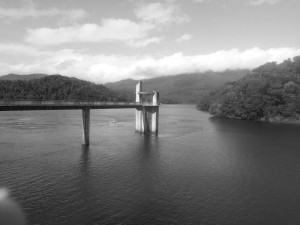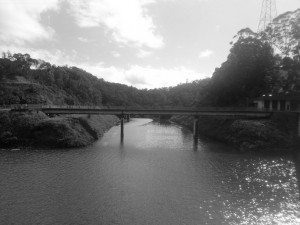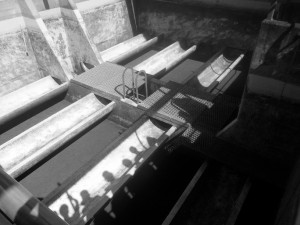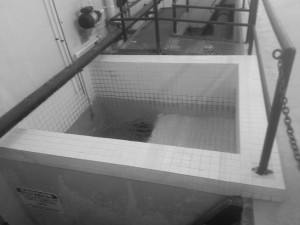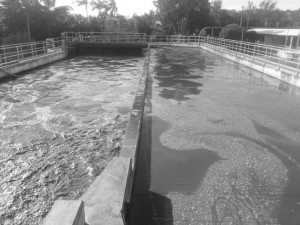Introduction
Cairns is a coastal city in tropical Far North Queensland. The local authority, Cairns Regional Council (CRC), serves an area of 4129 km2 and a population of approximately 165,000 – which has increased by 37,000 since 2002 (CRC, 2013). CRC owns and operates the town water supply systems in the urban parts of its area. Raw water is extracted from 15 locations and is stored in 76 reservoirs after treatment. The main population area – Cairns city and suburbs – is supplied from Copperlode Falls Dam and Behana Creek (CRC, n.d.).
Copperlode Dam has a capacity of 37GL and a maximum extraction flow of 123ML/day. Water extraction is entirely gravity fed (Reimann, D., pers. comm., July 23, 2013). The water from Copperlode Dam and Behana Creek is treated at CRC’s Tunnel Hill water treatment plant (CRC, n.d.). After treatment and supply to the reticulation system, water samples from a number of points is tested for quality once a week by CRC’s Water Testing Laboratory (Wuth, M., pers. comm, July 23 2013).
When it has made the transition from drinking water to sewage, Cairns town water ends up at the Marlin Coast waste water treatment plant, which operates a bionutrient reduction system. Here, it is transformed from sewage, by an activated sludge process, into ‘A’ grade recycled water and a small amount of solid waste. The water is supplied to a local school and golf course for irrigation, and the remainder flows to Moon Creek and into the Coral Sea (Brown, G., pers. comm., July 23, 2013).
This report will examine each stage of this process in detail and will consider the pathways for potential future development.
Copperlode Dam
Reticulated water supplied in Cairns is mostly sourced from Lake Morris, also known as Copperlode Dam. The dam is situated approximately 400m above the city and is fed by a catchment area of 44km2 with an annual rainfall of approximately 2.9m. The lake has a shoreline 72km long and a capacity of 37GL. It was built in 1976 and its original capacity was 43GL, but siltation has reduced that by 6GL – a reduction in capacity of approximately 0.4% per year (Reimann, D., pers. comm., July 23, 2013).
The dam wall is 120m long and the top is 30m above the natural creek bed in the lake. It is built from earth and rock and has 24 piezometers built into it to monitor the core pressure. Because of the downstrearm population, it is classified as a hazardous dam and frequent inspections are carried out (Reimann, D., pers. comm., July 23, 2013).
The water supplied from Lake Morris is entirely gravity fed. It is released into Freshwater Creek on the outside of the dam wall and flows down to Crystal Cascades, where is is taken out and piped to the water treatment plant at Tunnel Hill. There are several waterfalls on the way down the creek and the water is well aerated by the time it gets to Crystal Cascades (Reimann, D., pers. comm., July 23, 2013).
There is, however, an aeration system in the lake to improve water quality and reduce turbidity. When the dam was first built there was a problem with iron and manganese in the water and the aeration system was installed to oxidize these metals and reduce their solubility, eliminating them from the water supply. This aeration system uses a considerable amount of power and costs approximately $90,000 a year to run. An alternative system is being developed which is expected to reduce power costs by about $65,000 a year (Reimann, D., pers. comm., July 23, 2013).
Because of the aeration system, there is only a 4° difference in temperature between the top and bottom of the lake and dissolved oxygen levels are fairly constant. However water can be released from the lake via ten different levels of valves, so it can be taken from different levels in the lake, depending on dissolved oxygen levels and turbidity, etc. Water release is controlled on a real time basis to adapt to demand (Reimann, D., pers. comm., July 23, 2013).
Maximum extraction through the dam wall is 1.42 m3s‑1 (123ML/day), but when the dam is full up to 710 m3s‑1 may flow over the spillway, with a possible maximum flood capacity of up to 908 m3s‑1 – which equates to a water level 3m above the spillway wall. Water flowing over the spillway joins the water flowing through the dam wall and continues down Freshwater Creek to Crystal Cascades and on into the Barron River (Reimann, D., pers. comm., July 23, 2013).
No access to the water of Lake Morris is permitted, in order to prevent the introduction of blue green algae and to keep the water clean. Only minimal treatment is required before the water can be fed into the reticulation system (Reimann, D., pers. comm., July 23, 2013).
Tunnel Hill water treatment plant
Water from Lake Morris is extracted from Freshwater Creek above Crystal Cascades and piped to a reservoir at the Tunnel Hill water treatment plant along with water from Behana creek, Cairns’ other water source. When the water arrives there the tubidity ranges from 2.5 NTU to nearly 1000 NTU at times during the wet season. Alkalinity is low and the water is soft (Dore, L., pers. comm., July 23, 2013).
Before being filtered, the water is treated with alum and a non-ionic polymer, which act as flocculants – causing suspended particles to clump together and precipitate out. The water is then filtered in beds containing sand, gravel, and anthracite. The main function of the anthracite is to facilitate the backwash process by breaking up and allowing sediment to be washed away. The filters are regularly backwashed to clean them and the water used for this is sent to sewage. Filtration reduces the turbidity of the water to 0.02 NTU (Dore, L., pers. comm., July 23, 2013).
After filtering, the water is chlorinated, using sodium hypochlorite, and flows into a contact reservoir where its residence time allows the chlorine to kill any potential pathogens and then to oxidise the resulting trihalomethanes and other products of the chlorination process. The alum, which was added as a flocculant, lowers the pH and although this isn’t harmful to humans, it corrodes the pipes. To counteract this, the water is treated with sodium carbonate at this stage, which brings the pH back up to neutral (Dore, L., pers. comm., July 23, 2013).
From the contact reservoir the water, which now complies with the Australian drinking water guidelines, flows through a system of pipes to a number of suburban reservoirs for supply to homes and businesses. There are rechlorination plants in places along the way, to maintain residual chlorine levels in the water (Dore, L., pers. comm., July 23, 2013).
The water treatment plant is fully automated and has a comprehensive monitoring system. Water release from the Copperlode dam is controlled from the Tunnel Hill control room and reservoir levels around Cairns are monitored there. The water flowing through the treatment plant is continuously monitored for raw turbidity, filtered turbidity, residual chlorine, and pH. Bench tests are also conducted three times a week, using calibrated instruments (Dore, L., pers. comm., July 23, 2013).
The plant’s normal operating range is from 400 to 1200 liters per second, or approximately 35 to 100 megaliters per day. Although the maximum amount of water that can be extracted from the dam is about 123 ML/day, the pipes from Crystal Cascades to Tunnel Hill operate at capacity during the peak demand period of the dry season, so no more water can be supplied without an infrastructure upgrade. This means there can be no significant expansion of the population of Cairns without such an upgrade (Dore, L., pers. comm., July 23, 2013).
Cairns Water Laboratory
Cairns Water Laboratory is operated by Cairns City Council. They test the quality of water from the reticulation system every week, sampling from over 100 points between Babinda and Daintree. As well as town water supplies, the laboratory tests samples from swimming pools, water intake points, landfill leachate, groundwater, and raw sewage (Wuth, M., pers. comm, July 23 2013).
The lab tests town water for turbidity, colour, heavy metals and other metals, pH, alkalinity, nutrients (phosphates etc). Chlorine content and temperature are tested with a meter at the sample site. Water is also tested for bacteria at all stages of its progress from the dam to the tap. Tests for Escherichia coli are carried out on the raw water, after UV exposure, and post chlorination. E. coli is tested for because it is an indicator of possible contamination, rather than because it is necessarily dangerous itself. A heterotrophic plate count is also carried out, to show any increase in bacteria before it becomes critical (Wuth, M., pers. comm, July 23 2013).
Marlin Coast water treatment plant
When the water from Copperlode Dam has passed through the reticulation system, most of it ends up in the sewers, along with various other of society’s waste products. The sewerage system flows to a sewage treatment plant – of which the Marlin Coast plant is one. This plant operates a bionutrient reduction process, which aims to separate all solid matter and most of the dissolved nutrients (e.g., nitrates and phosphates) from the water (Brown, G., pers. comm., July 23, 2013).
When it first arrives at the treatment plant, the raw sewage flows into a preliminary treatment area (PTA), where it passes through a screen to take out all foreign matter, and a grit removal system which removes grit from pipe repairs, peas, and other small hard particles which can damage or block the treatment equipment. The fumes are extracted from the PTA to an odour control unit, where they pass through a filter and a scrubber and exit via a stack. The inspection trapdoors on the PTA are secured shut as an 800 litres per second surge passes through the unit in the morning and unsecured trapdoors would allow it to spray everywhere (Brown, G., pers. comm., July 23, 2013).
From the PTA, the sewage flows into a bioreactor where it is mixed with returned activated sludge and then flows through an aerobic zone and an anoxic zone which both contain mixers followed by an aeration zone where air is pumped through it. Scum hoppers channel the scum into scum wells (Brown, G., pers. comm., July 23, 2013).
From the bioreactors, the liquor flows through clarifiers, where suspended solids are removed from the liquid stream, before entering the filter lift station and filters. From the filters it passes through an ultraviolet disinfection stage and chlorinator into a chlorine contact tank, with a residence time of 30 minutes. This stage incorporates chlorine and pH testing meters (Brown, G., pers. comm., July 23, 2013).
When the liquid leaves the chlorination residence tank it is ‘A’ grade recycled water. This water is piped to the golf course and a school for use in irrigation systems. There are plans to build a new system to treat this water to ‘A+’ grade and feed it to Smithfield Village. The pipework is in place, but the plant has yet to be built. Any water that is not supplied to the golf course or the school is currently released into Moon Creek, which flows past the treatment plant (Brown, G., pers. comm., July 23, 2013).
Water being released into the creek is automatically sampled every 30 minutes and the combined samples are tested dailiy. The Environmental Protection Agency tests bore samples of groundwater regularly. There is no testing for residual pharmaceutical drugs in the discharge water (Brown, G., pers. comm., July 23, 2013).
The solids stream from the clarifiers is pumped to an aerobic digestion tank where it is continually mixed and circulated. Some of this activated sludge is fed back to the first stage bioreactor and some is removed as waste activated sludge (WAS) for disposal in landfill. The WAS is pumped through a thickener and a lime clarifier and is then pressed until it is almost dry. This dry sludge is then loaded via a stacker into a bin for disposal in landfill. By this stage, it is odorless and has a texture similar to soil (Brown, G., pers. comm., July 23, 2013).
The future
The population of Cairns has increased by about 20% over the last decade (profile.id, 2013) and a similar growth rate is predicted to continue until at least 2031 (forecast.id, 2011). Such population growth will require strategies for either increasing the water supply or drastically reducing demand. Although water extraction from Copperlode Dam is not at its maximum, the pipe from Crystal Cascades to Tunnell Hill is currently at capacity (Dore, L., pers. comm., July 23, 2013). But, although dam extraction could be increased, the dam itself may not be able to reliably supply a much bigger population – water restrictions were imposed in January 2013 (Parsons, 2013a) – and CRC are starting to look at other options including demand reduction strategies (CRC, 2009a).
An option that is currently being considered by CRC is the Mulgrave River aquifer bore field which would be located at Aloomba, south east of Gordonvale. This project has been determined to be a controlled action under the Environment Protection and Biodiversity Conservation Act 1999 as it is likely to impact on World Heritage Areas, listed threatened species and communities, and listed migratory species (Acting assistant secretary, 2005). It is planned that this borefield will supply up to 15ML of water per day and act as a complementary supply for the southern part of the CRC area (CRC, 2009b). There is, however, some concern that extraction of water from Mulgrave River will be detrimental to the local ecology and to farming (Parsons, 2013b).
These measures may help CRC keep up with the increasing demand for water in the near future, but it is not clear where the water will come from to supply a population that is predicted to be 33.5% bigger by 2031 (forecast.id, 2011).
References
Acting assistant secretary (2005) Decision on controlled actions (Environment Protection and Biodiversity Conservation Act 1999). Canberra: Dept of Environment and Heritage. Retrieved from http://www.environment.gov.au/cgi-bin/epbc/epbc_ap.pl?name=show_document;document_id=20396;proposal_id=2390 on 12/9/13.
Cairns Regional Council (no date) Environment, water & waste. Cairns, Qld: Cairns Regional Council. http://www.cairns.qld.gov.au/environment/water-and-waste/water-sources-supply on 12/9/13.
Cairns Regional Council (2009a) Water demand management strategy. Cairns, Qld: Cairns Regional Council.
Cairns Regional Council (2009b) Mulgrave River Aquifer Feasibility Study Public Environment Report. Cairns, Qld: Cairns Regional Council.
forecast.id (2011) Cairns Regional Council population forecasts. Collingwood, Vic: .id. Retrieved from http://forecast2.id.com.au/Default.aspx?id=363&pg=5000 on 12/9/14.
profile.id (2013) Cairns Regional Council area Community Profile. Collingwood, Vic: .id. Retrieved from http://profile.id.com.au/cairns/home on 12/9/13.
Parsons, L. (2013a) Water restrictions are in force. Cairns Post. Cairns, Qld. Retrieved from http://www.cairns.com.au/article/2013/01/04/238157_local-news.html on 12/9/13.
Parsons, L. (2013b) Search for secure water supply for Cairns region. Cairns Post. Cairns, Qld. Retrieved from http://www.cairns.com.au/article/2013/09/11/247981_local-news.html on 12/9/13.
